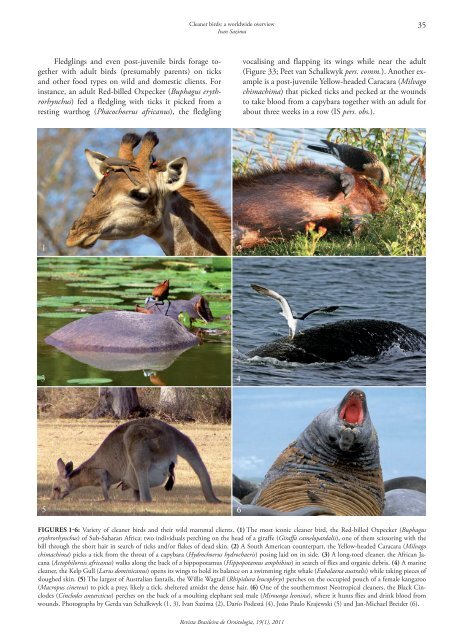Capa 19(1) - fechada.indd - Sociedade Brasileira de Ornitologia
Capa 19(1) - fechada.indd - Sociedade Brasileira de Ornitologia
Capa 19(1) - fechada.indd - Sociedade Brasileira de Ornitologia
You also want an ePaper? Increase the reach of your titles
YUMPU automatically turns print PDFs into web optimized ePapers that Google loves.
Cleaner birds: a worldwi<strong>de</strong> overview<br />
Ivan Sazima<br />
35<br />
Fledglings and even post-juvenile birds forage together<br />
with adult birds (presumably parents) on ticks<br />
and other food types on wild and domestic clients. For<br />
instance, an adult Red-billed Oxpecker (Buphagus erythrorhynchus)<br />
fed a fledgling with ticks it picked from a<br />
resting warthog (Phacochoerus africanus), the fledgling<br />
vocalising and flapping its wings while near the adult<br />
(Figure 33; Peet van Schalkwyk pers. comm.). Another example<br />
is a post-juvenile Yellow-hea<strong>de</strong>d Caracara (Milvago<br />
chimachima) that picked ticks and pecked at the wounds<br />
to take blood from a capybara together with an adult for<br />
about three weeks in a row (IS pers. obs.).<br />
Figures 1‐6: Variety of cleaner birds and their wild mammal clients. (1) The most iconic cleaner bird, the Red-billed Oxpecker (Buphagus<br />
erythrorhynchus) of Sub-Saharan Africa: two individuals perching on the head of a giraffe (Giraffa camelopardalis), one of them scissoring with the<br />
bill through the short hair in search of ticks and/or flakes of <strong>de</strong>ad skin. (2) A South American counterpart, the Yellow-hea<strong>de</strong>d Caracara (Milvago<br />
chimachima) picks a tick from the throat of a capybara (Hydrochoerus hydrochaeris) posing laid on its si<strong>de</strong>. (3) A long-toed cleaner, the African Jacana<br />
(Actophilornis africanus) walks along the back of a hippopotamus (Hippopotamus amphibius) in search of flies and organic <strong>de</strong>bris. (4) A marine<br />
cleaner, the Kelp Gull (Larus dominicanus) opens its wings to hold its balance on a swimming right whale (Eubalaena australis) while taking pieces of<br />
sloughed skin. (5) The largest of Australian fantails, the Willie Wagtail (Rhipidura leucophrys) perches on the occupied pouch of a female kangaroo<br />
(Macropus cinereus) to pick a prey, likely a tick, sheltered amidst the <strong>de</strong>nse hair. (6) One of the southernmost Neotropical cleaners, the Black Cinclo<strong>de</strong>s<br />
(Cinclo<strong>de</strong>s antarcticus) perches on the back of a moulting elephant seal male (Mirounga leonina), where it hunts flies and drink blood from<br />
wounds. Photographs by Gerda van Schalkwyk (1, 3), Ivan Sazima (2), Darío Po<strong>de</strong>stá (4), João Paulo Krajewski (5) and Jan-Michael Brei<strong>de</strong>r (6).<br />
Revista <strong>Brasileira</strong> <strong>de</strong> <strong>Ornitologia</strong>, <strong>19</strong>(1), 2011

















